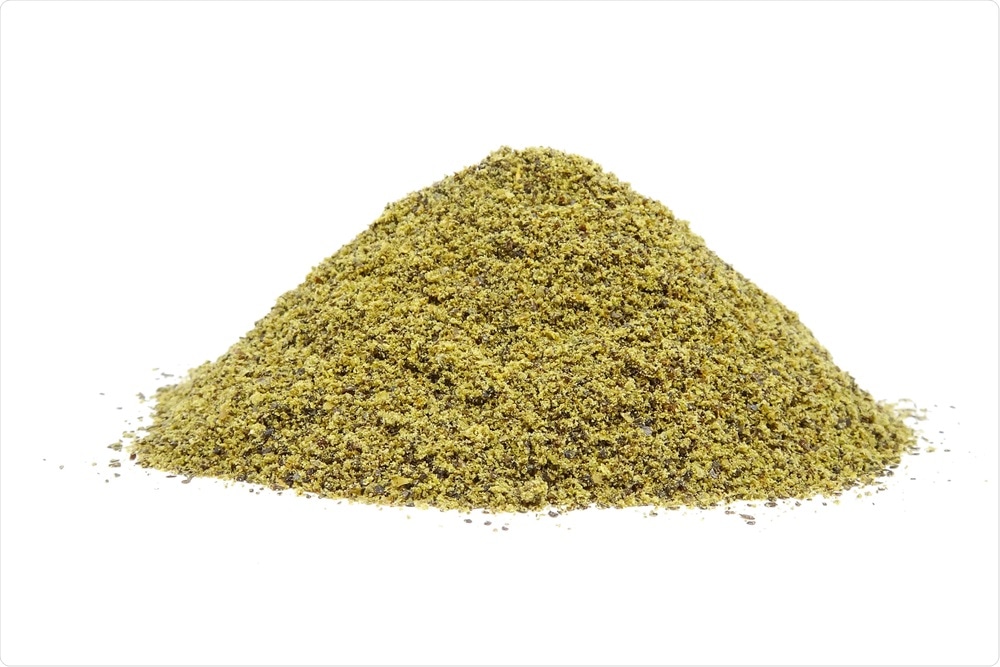Researchers in Italy have developed an innovative new platform that can detect residual cannabinoid content in commercially available hemp flours.

Image Credit: 12photography/Shutterstock.com
The miniaturized automated platform, which is based on a MicroNIR/Chemometrics approach, provides real-time screening for the detection of cannabinoids in the products.
About hemp-based products
Hemp-based products have increasingly captured attention as promising cannabis-derived materials containing molecules with nutraceutical and functional properties, including cannabinoids.
Containing up to more than 70 cannabinoids, the hemp plant is considered the most attractive product to food vendors and is commonly monitored by law enforcement agencies.
Among the cannabinoids present in hemp flour, the psychotropic tetrahydrocannabinol (THC) has the greatest binding affinity with cannabinoid (CB) receptors CB1 and CB2. Although the non-psychotropic cannabidiol (CBD) and cannabigerol (CBG) do not possess CB binding affinity, they are also often monitored due to their medicinal properties.
Monitoring residual cannabinoid content
The greatest quantity of cannabinoid is found in the top part of the hemp plant and a lesser amount is found lower down in the leaves, meaning that although hemp flour is derived from hemp seeds, it does not usually contain cannabinoids.
However, contamination often occurs during harvesting. Currently, the Italian regulations require that the THC residual content is less than the instrumental limit of detection, meaning there are growing concerns surrounding the monitoring process of hemp-based products.
Current confirmation techniques include chromatographic methods such as gas chromatography-mass spectrometry (GC-MS) and high-performance liquid chromatography-mass spectrometry (HPLC-MS). However, studies have recently reported that high-resolution NMR is an innovative approach to monitoring cannabinoids.
Writing in the journal Talanta, Roberta Risoluti (“Sapienza” University of Rome, Italy) and colleagues say they think spectroscopic techniques should be added to the list, since they provide non-destructive and accurate detection of analytes in complex mixtures, without requiring sample preparation.
The chemometric and NIR spectroscopy approaches
Furthermore, the use of chemometric tools has been reported as helpful in the interpretation of the complex signals generated by multivariate spectral data, allowing matrix-derived interferences to be evaluated and the contribution of the analyte of interest confirmed.
Of the various spectroscopic methods, near-infrared (NIR) spectroscopy is often used for various site applications that use portable handheld NIR devices.
Now, Risoluti and team have proposed a miniaturized microNIR/Chemometrics- based portable platform for the real-time monitoring of residual CBD, THC, and CBG in hemp flours.
What did the study involve?
For the study, ten commercially available hemp flour samples were analyzed using a microNIR platform and GC-MS, for comparison purposes.
The chemometrics approach to comparing the microNIR spectra enabled the team to develop models that could accurately predict residual cannabinoid content in a real-time analysis that took just a few seconds.
The capabilities of the platform to detect all the cannabinoids simultaneously were also evaluated, to check the ability of the model in differentiating them with no misclassification outcomes. This is the main advantage of the coupling approach of chemometrics to microNIR analysis: in fact, the multiparametric tools may help in interpreting results of complex matrices by selecting the most descriptive region of the spectra, reducing noise and enhancing the contribution of the analyte with respect to interferences.”
What did the researchers find?
The team reports that the GC-MS analysis only identified residual cannabinoid content (0.03% CBD) in one of the ten samples tested. The microNIR outcomes were in good accordance with the GC-MS results. MicroNIR also identified the same nine samples as negative for cannabinoid content and identified the residual CBD content in the contaminated sample as about 0.05%.
“The platform is sensitive and precise to be used as a first-level test for forensic purposes and permit to address only suspected samples to further confirmatory analysis by the reference procedures,” the team concludes.
Journal reference:
Risoluti R, et al. Monitoring of cannabinoids in hemp flours by MicroNIR/Chemometrics. Talanta 2020;211 https://doi.org/10.1016/j.talanta.2019.120672